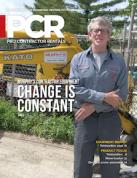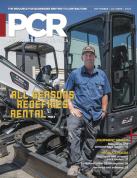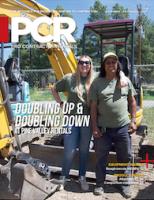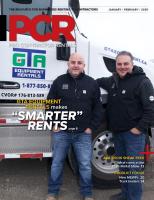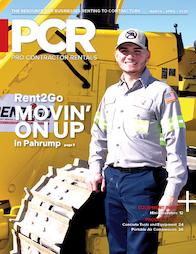Rental Solution:
Are solid tires right for your fleet?
Figure what flat tires cost you.
by Eric Hartzler
 |
| Flat tires frustrate customers. Every hour a customer spends waiting for a simple repair is an hour they can’t work, so your service team’s response time is critical in retaining that customer’s business. Solid tires can head off flat tires. |
Equipment downtime caused by flat tires is an all-too-common problem for rental companies, as well as a significant drain on resources.
The most obvious expense is the time and labor involved with repairing a tire. When a customer calls, you must dispatch a service tech to the job site to make the repair, which can take anywhere from an hour up to half a day, depending on how far away the machine is located. You will also incur costs for fuel, patch kits and possibly a new tire if you have to replace it because of the size and location of the puncture.
Those expenses are easy to add up, but flat tires can also hurt your reputation. Even though flat tires aren’t your fault, they frustrate customers. Every hour a customer spends waiting for a simple repair is an hour they can’t work the machine, so your service team’s response time is critical in retaining that customer’s business. If you don’t get there fast enough, they may decide to do business with a competitor that provides faster service — or whose equipment doesn’t get flat tires.
Flat-free solution
For these reasons, rental companies, large and small, are making the switch from pneumatic to solid tires on their most heavily used machines, like skid steer loaders
and telehandlers.
Because these machines typically are exposed to the harshest job conditions and are often abused because “it’s a rental,” solid tires provide a solution that will not go flat, which makes customers happy, eliminates tire-related service calls and helps reduce operating expenses.
Many rental company managers make the mistake of thinking that solid tires are only for demolition and scrap applications, but that simply isn’t true anymore. Manufacturers, like Midwest Equipment Sales (MWE), have made several improvements in the design and construction of solid tires, making them more versatile in a variety of applications and ground conditions as well as improving ride comfort for the operator.
 |
| Many rental company managers make the mistake of thinking that solid tires are only for demolition and scrap applications, but that simply isn’t true anymore. |
Long-term economics
One of the primary reasons that rental companies are making the change to solid tires is because the savings add up over time. Fixing and replacing punctured tires gets costly and so does frequently having to replace worn tires. You will also eliminate service-related calls about flat tires. Those savings across a fleet of skid steers and telehandlers will give you a greater return on your equipment and tire investment.
Operator comfort
A common concern rental fleet managers share is whether they will get pushback about ride comfort from their customers. After working with hundreds of rental stores throughout North America, MWE says with certainty that most operators do not have an issue
running a machine with solid tires.
Since contractors are typically renting to supplement their fleet, they don’t spend all day behind the controls. Even if they did, there have been many advancements made in the engineering of solid tires in recent years.
 |
| The R-4 swept lug tread pattern is the most common design used on skid steer loaders and is best suited for dirt and mud. |
Most manufacturers now offer solid tires with apertures built into the sidewall. These holes were first introduced on larger equipment tires, but now are common in the compact equipment categories. These holes reduce the weight of the tires and improve the ride quality when a machine is under load.
Tread options
A tire’s tread pattern will also help improve the ride comfort for customers and help get the best life from the tires.
For telehandlers, most manufacturers of solid tires only offer a standard swept lug pattern similar the pneumatic tire style the original equipment manufacturer (OEM) supplied.
With skid-steer loaders, there are more tread pattern options and manufacturers from which to choose. The three primary tread patterns to look at includes a swept lug, a diamond lug and a smooth tire.
The R-4 swept lug tread pattern is the most common design used on skid-steer loaders; it is best suited for dirt and mud. The L-5 diamond lug tread pattern is used more for hard surface applications. However, if a machine is being used on dry, hard surfaces, like a recycling facility, smooth tires provide longer operating life.
If the equipment fleet is being used in dirt and on hard surfaces, like most rental equipment, rental companies should consider more of a hybrid option, like the MWE Solid HD skid steer tire, which has deep tread lugs for long wear and tapered voids to promote self-cleaning.
 |
|
If a machine is being used on dry, hard surfaces, like a recycling facility, smooth tires provide a longer |
Build quality
As with any equipment tire, the quality of tire construction varies widely between manufacturers.
There is a wide variety of materials used in the construction of a solid tire. Quality tires use a different rubber compound in the middle of the tire than on the outside of the tire. This reduces heat generation, which will extend the life of the tire.
Also, a different filler material is used around the rim. Low-cost tires will use materials like newspaper and twine for filler, while quality tires will use materials like recycled rubber
and nylon.
To the typical buyer, there will likely be no difference in appearance. To assure you are purchasing quality solid tires, look at the weight of the tire — quality tires weigh more.
Offer customers options
For most applications, solid tires are an excellent choice for rental companies. However, it is a good idea to still have a few units with pneumatic tires or tracks. Solid tires add weight to the machine, and if customers are working on turf or in soft conditions, they will want better flotation than what solid tires can deliver.
Finally, if you’re still not sure if solid tires are right for the needs of your customers, ask them. Visit with other rental companies that are using them on their equipment or talk to a knowledgeable compact equipment tire distributor.
The upfront cost of solid-tire assemblies may seem high, but cost-per-hour on the life of a solid tire is significantly lower than its pneumatic counterpart. A solid tire can last up to ten times longer than an air-filled tire.
Eric Hartzler is wholesale manager at MWE, which produces tires and tracks for a variety of equipment.





